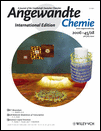Cover Picture: A Conjugated Polycarbazole Ring around a Porphyrin (Angew. Chem. Int. Ed. 28/2006)
Abstract
Like the rings of Saturn a fully conjugated cyclododeca-2,7-carbazole surrounds a porphyrin template. The macrocycle can be released from the template. The cover shows a single-molecule STM measurement with the structure of cyclododeca-2,7-carbazole in the foreground. The tunneling current is dominated by the conjugated cyclic structure and shows an “electronic hole” in the center. For further details on these molecules and their self-assembly into columnar stacks see the Communication by K. Müllen et al. on page 4685 ff.




